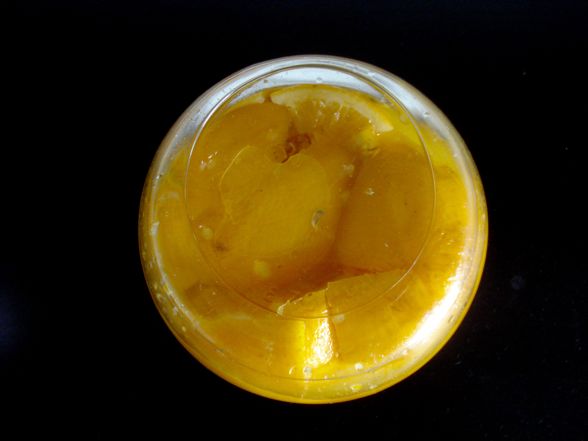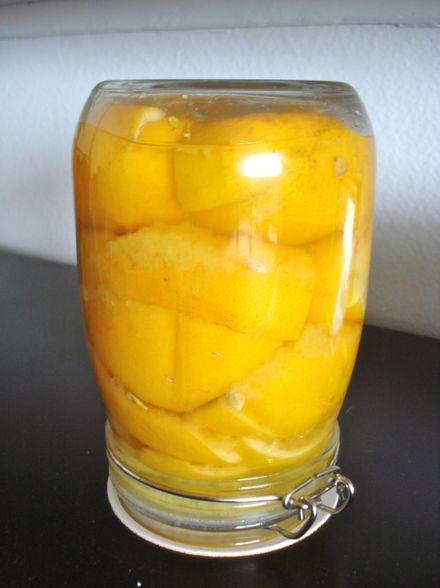It seemed so simple. To make preserved lemons, all I had to do was quarter a bunch of lemons, treat them liberally with salt, toss them in a jar, add some lemon juice, close it up, and let ‘er rip. But now that the lemons have been preserving for a week, I have some major concerns. You see, the recipe that I used (and furthermore, many of the recipes I referenced) claimed that as time went on, the salt would draw out the juices of the lemons, thus submerging the rinds and allowing for safe and peaceful preservation. That has not happened though. Or rather, it’s only partially happened.
As it turns out, my first post about preserving lemons drew much concern from some of the readers as they felt evil bacteria might grow, what with all the air left in the jar. I dismissed this concern at first, but my hypochondriacal impulses soon took over. What if they were right? No big deal. I set about squeezing more lemon juice into the jar (I regretfully used a Eureka lemon as I had run out of Meyers). However, try as I may, there were two things I could not do: fill up the jar all the way and submerge the lemons. The problem is that the jar lid has a little pocket in its exterior, and as a result, there will always be air inside (note the jar inverted, above). More troubling, however, is that the lemon rinds float in the salty solution, and so even though there’s enough lemon juice in the jar to easily cover the rinds, they still float to the top, with the uppermost ones ascending out of the liquid and into the air pocket. At this point, I assumed the lemons would continue to exude their juice, filling up the air pocket in the process, but so far, no dice. I have some serious concerns that this project might end in disaster. Then again, salty lemon juice is not the most amenable environment for bacteria to grow in. Hmmm…
At least I can take solace in knowing that the jar of lemons at least LOOK nice.
Developing…


Oh B, you always make lemonade out of lemons.
hb
HB FTW!
Maybe add in more salt? The salt kills the bacteria you’re worried about and should draw out more liquid… Maybe…
I say add vodka and make preserved ALCOHOLIC lemons. YUM!
I am on board with this.
Well, worst case scenario you can keep them as a biological weapon in case the Russians invade.
There’s a link at chowhound. Read all of the comments. I would omit the oil from the recipe.
http://chowhound.chow.com/topics/362217?tag=post-content-2413616%3bpost_2413616_content
The jar does look door, all spring timey I hate it when a plan just doesn’t not come together
Try candied lemon peel sweet and they sorta taste like those fruit slice candies
Still a pretty decoration for a table and great conversation piece.
Have faith. It still may work.
First sign of the mold will be a white “fuzz” look.
Oh Ben, you always do everything so wonderfully I am sure they will turn out just peachy.
I would label this as organic art. They really do look pretty against the black bookcase. They’ll still look nice when they turn green also.
I agree with Shanti. Right now, it’s kind of a blah-ness of yellow. Green and/or white or black would add some drama to your lemons.
It’s a sealed jar. Right? If so, there’s no place for air to go and some pressure could be building up in there. Take care when removing the lid!
Maybe use a Ball jar? They’re specifically designed for this sort of thing.
Heh heh, you said ball
So I too have made lemon confit as it was called in the French cookbook that convinced me to make it. It looks pretty much the same as yours but I used tons of kosher salt and it hasn’t all dissolved. Also I used neighborhood lemons. My recipe said not to even open them for 90 days, and to keep them in the fridge. I regrettably have not used them yet though in a recipe (you only use the rind). I have opened it and tasted it, it is strong (90 days have passed).
I don’t understand why anyone who can go to a store and buy lemons, at all times of the year, would do this. I don’t get it.
When do we eat them? And how? Do we spread them on toast or crackers? I’m totally willing to play guinea pig.
This is a learning experience for all of us now. You’ve hooked me, so keep us in the loop.
I do a lot of canning and preserving. There isn’t much else to do when you live in the middle of nowhere, but you used the wrong type of jar for this. A jar that is made for canning would keep the air out of the top. I would caution against using the lemons and try again with the proper jar.
And anothr “how to”
http://www.ehow.com/how_5710134_preserve-meyer-lemons-kosher-salt.html
Botulinum inhibits the body’s production of acetylcholine within the nervous system, the chemical that produces a bridge across synapses, where nerve cell axons and dendrites connect with each other. All forms lead to paralysis that typically starts with the muscles of the face and then spreads towards the limbs.-‘;’
Look over our personal blog as well
<http://www.caramoanpackage.com/